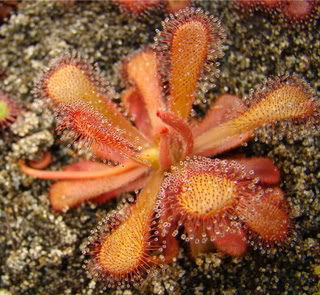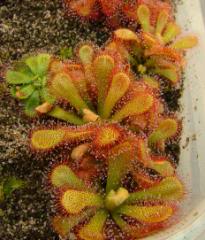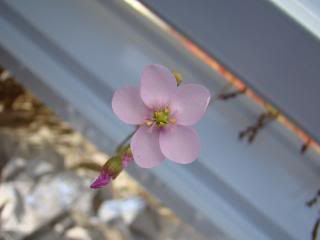Drosera venustaDrosera venusta, sometimes referred to as the Elegant Sundew, is a very impressive-looking specimen. Its large size, orange-red coloration, and broad leaves make it one of my personal favorites. Drosera venusta is a rosetted sundew that originates from the subtropical climate of South Africa. Some sources consider Drosera venusta synonymous with Drosera natalensis, although I think they should be considered seperately. As a vigorous and easy-growing sundew, Drosera venusta makes a great plant for the beginner to expert sundew enthusiast. |
|

|
Media: 1:1 peat: sand (silica) is best. Small amounts of perlite can be added as well. I have also seen Drosra venusta grown successfully in 100% dead or living long-fibered sphagnum moss. Make sure to rinse your media before using it. Media moisture: try to always keep the media moist. Drosera venusta has tolerated waterlogged soils better than most South African sundews in my experience. Humidity: I'd recommend above 50-60%. Try 75-85+% if you want the most dew. Pot height: 4 inches or taller recommended. Drosera venusta can develop a a long, branching root system. A tall pot will ensure that the plant will never be effected by root rot. Trapping speed: moderate. Leaves will bend noticeably around food within a few hours. Feeding: Try to feed once every 2-4 weeks for rapid, robust growth and flower production. See feeding page. Feeding encourages flowering. If fed while flowering, the plant will start producing large leaves right away. Food size: medium to small. Plant dimensions: D. venusta can get up to 3 inches across. The plant in the first picture has 1.5 inch leaves. Leaves can also grow a half inch+ wide. It tends to form a "skirt" of old growth over time as it increases in height. Temperature: not picky. Has grown well for me in the temp range of 60-90 degrees F. Give it subtropical conditions. Lighting/Photoperiod: I grow mine under T-8 lights with a 16-hour photoperiod. They will turn orange-red under intense lighting. Dormancy requirements: None required. Can be grown year-round if grown indoors during the cold months. Will die down and come back from the roots if you subject it to freezing conditions. I have noticed that my Drosera venusta "Coccicaulis" weakens considerably after flowering, sometimes curling horizontally to the soil. I end up cutting it down to the roots, and taking a stem cutting, producing many more sundews when the roots shoot up new plants. Flowers: Drosera venusta produces huge flower stalks with beautiful, compact pink flowers (see picture to the left). Try self-pollination for better seed-set. Avoid hot temps during this time. Each flower will produce many seeds elongated, resembling those of D. binata. Propagation TechniquesSeed: easy. no cold stratification required. Can be grown to flowering maturity from seed in a year if fed approx. every 2 weeks. Leaf-cuttings: easy. water floating method works best. Place directly uner lights for the hightest success rate. Root cuttings: Very easy! 10 plants can be produced from a 2-inch cutting (see middle picture to the left). The plants in this picture are only 6-months old (have been fed often). Divisions: Drosera venusta may form clumps over time. Drosera venusta has no trouble dealing with repotting and root disturbance, so divisions can be taken easily. |
Additional Questions or Suggestions?
Contact me at: sundewman(at)yahoo.com

